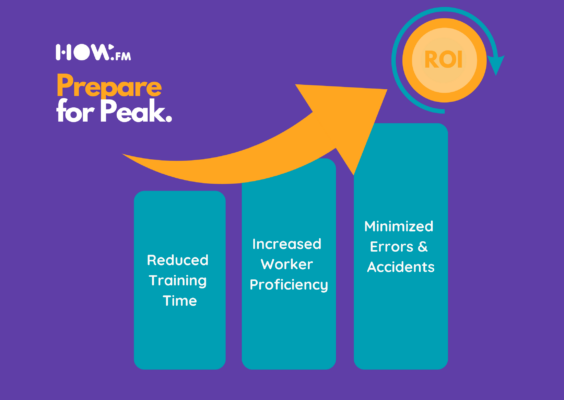In the dynamic logistics industry, peak seasons have heightened demands and increased challenges. Successful operations become essential at these crucial times.
This article delves into the important role of effective onboarding in ensuring a seamless transition for new employees during peak seasons.
Additionally, it emphasizes the sizable return on investment (ROI) that may be attained via an effective onboarding process.
The significance of how.fm, a cutting-edge platform that improves onboarding procedures, is highlighted in the debate.
By examining key factors such as reduced training time, improved worker proficiency, and reduced errors, this article demonstrates the way how.fm’s innovative solution contributes to the success of logistics companies during their busiest times of the year.
Let’s begin!

Section 1: Understanding the Importance of Effective Onboarding during Peak Season
1.1: The Significance of Onboarding in Peak Season Performance:
The process of integrating new team members becomes a significant relevance when peak seasons burst out.
It’s important to promote a healthy fusion between the staff and the increased operational needs; this goes beyond just filling open jobs.
Effective onboarding best practices, which go beyond simple administrative procedures, are at the forefront of this crucial endeavor.
It acts as the pillar that supports worker productivity, ignites overall effectiveness, and guides operational success through choppy peaks.
The importance of onboarding in this scenario goes much beyond paperwork and orientation sessions.
It serves as the catalyst for bridging the gap between theoretical knowledge and practical application, allowing new recruits to fit into their jobs with ease.
This coherence is especially important during peak seasons when operations are under constant strain in all areas.
A successful onboarding process has two benefits. First of all, it provides recently hired staff with the necessary training and information to make a significant contribution right away.
This quick adaption is a strategic advantage, not just a convenience. Second, the very center of operations benefits from this skilful integration. Teams work like well-oiled equipment, tasks are carried out precisely, and communication is fluid.
Peak season demands are difficult by nature, with logistical complexities made worse by increased effort and raised expectations.
The onboarding procedure emerges in this test as a keystone that grounds operations, injects agility into personnel deployment, and puts the business in a position to not only withstand but thrive under duress.
The concept of digital onboarding gives this relevance a new depth as the digital age develops.
The effect of onboarding best practices is elevated to new levels of efficiency and agility via the fusion of technology and seamless integration, which proves to be a powerful ally in handling the demands of peak seasons.
1.2 The ROI of Effective Onboarding:
The idea of return on investment (ROI) is a guide for making wise decisions in the world of business strategy.
The same concept also has an effect on the complex area of onboarding, and at peak times, this influence has a significant and verifiable impact.
Effective onboarding has a profoundly transforming effect on a variety of levels. A noticeable improvement in cost reductions sits at the core of this shift.
Logistics businesses reveal a simplified method that cuts down on training time by improving onboarding procedures.
As a result, there will be significant cost savings since the resources previously devoted to lengthy training sessions will now be used for the main business activities that generate income.
The outcomes are obvious: more effective resource allocation and a significant improvement in the bottom line.
However, the benefits of efficient onboarding go beyond just financial ones. They also cover the topic of productivity improvement, which is more important during the demanding peak seasons.
Employees are not only prepared for their responsibilities thanks to a well-planned onboarding process; it also gives them the tools they need to succeed.
New recruits’ competency rises as they negotiate the steep learning curve. This growth in worker knowledge has an impact on the whole company, leading to greater output quality and productivity.
Increased worker proficiency has a cascading effect that results in change outside of internal measurements.
It results in a series of advantages centered on the consumer. Effective onboarding has a greater impact because of its skilled and empowered team.
Customers form an image of staff via interactions with them that go beyond competence to confidence, and this impression reverberates through good feedback and repeat business.

Section 2: Key Metrics for Measuring ROI in Onboarding
2.1 Reduced Training Time:
Agility becomes essential when it comes to peak seasons. Rapid adaptability is not simply desirable; it is also required. When it comes to balancing efficiency and quality, the idea of shorter training sessions becomes crucial.
The need for quick onboarding doesn’t mean that quality must be compromised. Instead, it involves striking a balance between the demand for quick integration and the need to provide new hires with critical training.
By cutting the length of the training period, logistics organizations open up a powerful path for new hires to start making valuable contributions more quickly.
This promptness serves as a stimulus rather than merely a convenience. It implies that recently onboarded team members move quickly from the learning phase to the action phase, bringing life to business operations.
Reduced training time has an influence on several aspects. The acceleration of production is first and foremost.
As new hires go through the learning curve with streamlined efficiency, their newly acquired abilities are quickly put to use in practical situations.
The end effect is a workforce that catches up more quickly and produces outcomes that support the operational rhythm rather than trying to catch up.
The implications, meanwhile, go beyond simple operational smoothness. Reduced training time results in measurable financial savings.
Resources that were before allotted to prolonged training sessions are now being recovered for more strategic uses.
The bottom line will be affected by this change in allocation since resources will now be allocated toward projects that will generate income, rather than lengthy teaching sessions.
Moreover, a condensed onboarding phase forges a workforce that is agile and primed for peak-season challenges.
A team that has planned can manage the additional workload and handle the rise in demand with ease.
During times of high demand, this operational capacity optimization is essential for ensuring that the business uses all its resources to meet and exceed consumer expectations.
2.2 Increased Worker Proficiency:
Successful onboarding involves creating a staff representing competency, excellence, and confidence. It goes beyond the scope of basic training.
This proficiency development is a strategic asset that leads to improved output quality and increased customer satisfaction; it is not only a consequence.
Effective onboarding is more than just a mechanical procedure; it catalyzes new hires into competent and valuable employees.
The effect is extensive and immediately affects the quality of the work produced. Competent workers go above and beyond the call of duty to infuse each job with a feeling of mastery, care for the little things, and dedication to perfection.
This improvement in product quality reverberates across the value chain and resonates with clients who quickly distinguish between competent execution and ordinary performance.
A feeling of confidence and capacity accompanies this newly acquired expertise. Employees are proficient in their work approach activities with a greater feeling of ownership than just carrying them out.
A more tailored and interesting customer experience results from this combination of expertise and confidence, raising customer happiness.
However, the benefits of improved worker competency go beyond dealing with customers.
They are felt across the business’s operating environment. An educated workforce is more capable of navigating the challenges of peak demand.
They are agile enough to adjust to sudden changes, resourceful enough to meet obstacles head-on and perform well under duress.
This operational strength gives the organization a clear competitive advantage, allowing it to stand out in a crowded market and satisfy customer demand.

2.3 Minimized Errors and Accidents:
The emphasis on safety and dependability sharpens at the accelerated pace of peak operational times.
Here, onboarding plays a more important function than ensuring competence; it acts as a safeguard, reducing mistakes, preventing accidents, and bolstering workplace safety.
Onboarding, often seen as a gateway to operational competence, is equally a portal to safety awareness.
Employees that have undergone a thorough onboarding process have the technical know-how and a keen understanding of safety procedures.
When the pace quickens and the expectations grow, this knowledge is a foundation of utmost significance.
The benefits of a skilled staff go well beyond everyday operations. They go beyond just preventing interruptions.
Employees who can overcome obstacles and follow safety protocols create a barrier against accidents.
Consequently, there are fewer operational snags, more efficient processes, and fewer accidents that could interrupt operational flow at crucial times.
Financial, operational, and long-term effects on the company’s image are all part of the impact.
The financial advantages are obvious—fewer accidents equates to reducing the monetary losses often following workplace occurrences.
However, the advantages persist long beyond the peak times and are not limited to them. A safer workforce provides the groundwork for a more dependable operational ecology, creating the conditions for more efficient operations, happier customers, and improved employee morale.
Beyond the pragmatic benefits, there’s an intangible yet impactful aspect. The company enhances its reputation as a safety-conscious business, bringing in clients and employees looking for dependability and security.
In this way, the effects go beyond the operating environment to the overall impression of the brand.
Section 3: how.fm: Enhancing Onboarding for Peak Season Performance
3.1 Introducing how.fm as an Onboarding Solution:
A transformational ally in the quest for onboarding excellence is how.fm. The ground-breaking technology transforms the onboarding environment and paves the way for quick and easy integration of new hires, especially during busy times of the year.
Let’s examine how.fm’s crucial contribution to the transformation of the onboarding process in more detail.
A dedication to simplifying onboarding is at the core of how.fm. The platform revolutionizes workers’ education by guaranteeing that the transition from beginners to expert contributors is defined by efficiency and efficacy.
Consequently, the staff is prepared and primed to succeed as soon as they set foot in the operating environment.
The interactive training modules of how.fm are the foundation of its power. These courses provide a stimulating and dynamic learning environment that encourages memory retention and practical application.
Employees actively participate in learning, internalizing ideas and skills via practical application.
This strategy goes beyond conventional training techniques, ensuring that new workers are immersed rather than merely instructed.
The onboarding process should be easy to navigate, and how.fm upholds this notion. The software has an intuitive user interface allowing quick understanding and simple navigation.
As a result of having easy access to the materials they need, new hires may quickly and easily settle into their responsibilities.
Communication knows no boundaries with how.fm.
Language barriers are eliminated by the platform’s multilingual support, which includes over 30 different languages.
With this inclusive strategy, everyone may participate in onboarding, making it a welcoming and rewarding experience.
3.2 Leveraging how.fm for Enhanced ROI in Onboarding:
In the pursuit of onboarding excellence, how.fm doesn’t just offer a solution—it offers a blueprint for maximizing ROI.
This cutting-edge technology transforms the onboarding environment into a world of increased efficiency, productivity, and performance, particularly during busy times of the year.
how.fm specifically designs its solution to support the three pillars of efficient onboarding: shorter training periods, increased worker competency, and fewer mistakes.
Additionally, how.fm meets the necessity for quick integration without sacrificing quality. It shortens training periods by promoting quick knowledge transfer, freeing up important resources for use in strategic projects.
The platform’s interactive training modules immerse recruits in engaging learning experiences.
The level of worker competency is raised as a result of this immersion. Employees actively interact with the learning material rather than just skimming the surface, quickly moving from beginners to experts.
This skill has a direct impact on both operational effectiveness and product quality.
In the area of cost reductions, how.fm’s beneficial effects on ROI become glaringly obvious.
Cutting training time results in direct cost savings, as it directs resources toward operational excellence instead of lengthy training sessions.
The company’s financial position is strengthened, and this redirection amplifies the bottom line.
A cascading impact on production results from an improvement in worker competency. Competent workers are the backbone of efficient operations, boosting output quality, expediting job completion, and increasing income creation.
A staff ready for greatness serves as a strategic advantage amid the chaos of peak season.
Operational needs increase dramatically at busy times of the year. how.fm’s contribution is disruptive because it gives the workforce the tools to respond quickly and confidently to this increased demand.
The platform’s influence ripples through more efficient operations and sustained performance, leaving a lasting legacy of improved performance outside peak times.

Maximizing Peak Season Performance with how.fm
Effective onboarding stands out as a strategic need during busy times. Integration alone isn’t enough; you must boost productivity, reduce mistakes, and provide measurable results.
The three pillars of success are a shorter training period, higher worker competency, and a defense against mistakes.
The solution provided by how.fm aligns perfectly with these pillars, thanks to its interactive training courses and user-friendly UI.
It equips logistics firms with the necessary tools to adeptly manage busy periods, effectively turning challenges into opportunities.
The result is a narrative of enhanced performance and increased ROI, even amidst demanding circumstances.
In essence, the significance of onboarding is undeniable—it acts as a catalyst that shapes performance.
With how.fm as a partner, this journey becomes a pursuit of operational excellence, tapping into peak potential, and ultimately yielding undeniable ROI.
Please reach out to us today if you’re interested in maximising the ROI of your onboarding process.
